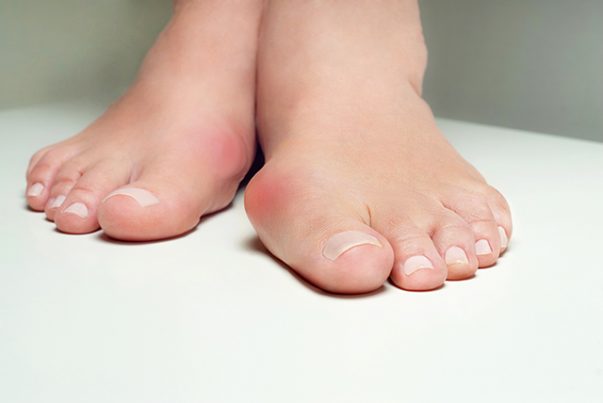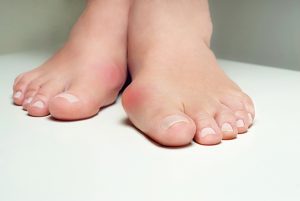
Bunion – causes, side effects and treatments at NaturalPedia.com
Saturday, January 27, 2018 by Ralph Flores
http://www.naturalpedia.com/bunion-causes-side-effects-and-treatments-at-naturalpedia-com.html

Bunions, also known as hallux valgus, is a misalignment of the bones in the feet, particularly the toes. Its medical term — hallux for the big toe and valgus for misalignment — aptly describes the condition. These are typically found at the joint at the base of the big toe.
A person suffering from a bunion will have an enlargement in the base of the big toe. This is where the misalignment in the joint of the big toe (also known as the metatarsal-phalangeal joint) is located. When this happens, the joint becomes inflamed, appears red, becomes tender to the touch, and radiates pain. The bones in the big toe become deformed and are pushed toward the smaller toes. In some cases, a fluid-filled sac near the joint called the bursa becomes inflamed as well, resulting in a more pronounced appearance. In later cases, this becomes even more painful with the onset of localized arthritis.
While bunions commonly are formed at the base of the big toe, they can also affect the base of the little toe on the outside of the foot (or lateral side). This is referred to as the tailor’s bunion, named after tailors in the olden times who sit cross-legged all day, with their outer feet rubbing on the ground.

Known causes and symptoms of bunions
The exact etiology of a bunion is not known. However, the condition is common to women. The condition is present in at least half of the women in the U.S., compared with only a quarter of men.
Moreover, heredity plays a part in developing bunions. Researchers believe that people suffering from bunions have inherited it from their parents or ancestors who share the same condition.
However, an anthropogenic cause of bunions is ill-fitting footwear. For existing cases of bunions, footwear that is too small, too tight, or fit poorly is exacerbated.
Bunions may not be painful at first. However, as the condition worsens, intermittent pain can be felt in the area where the bunion is located. In severe cases, a bony protrusion can be seen in the base of the big toe, as well as a burning sensation. The area will appear to be red and swollen, with radiating pain at the point of contact. Moreover, a person who suffers from severe cases of bunions may have limited movement, since he is limited by the discomfort of the affected toe.
Body systems affected by bunions
As bunions are a bone deformity, this mainly affects the musculoskeletal system of a person. In particular, this affects the metatarsal-phalangeal joint (MTPJ), the hindfoot, and the ankle.
Food items that may relieve bunions
Here are some food items that may help alleviate bunions:
- Turmeric, particularly its key component curcumin, has a pain-blocking ability. It also helps reduce the inflammation of the joint affected by bunions. While it can also be used topically, stir a teaspoon of turmeric powder in a glass of lukewarm water and drink it twice a day.
- Chamomile is also an effective herb that can soothe discomfort from bunions. Brew a cup of chamomile tea and sip it while it is warm. Do not discard the used tea bag and apply it directly on the bunion.
Treating and managing bunions
Bunions are usually treated without the need for surgery, depending on its severity. Some non-surgical treatments include:
- Shoe inserts (or orthotics), that relieve pressure on the shoe.
- Padding, taping or splinting of the toe.
- Applying ice to reduce pain and swelling.
- Cortisone injections to relieve swelling and inflammation.
When bunions are severe, surgery may be required to treat bunions. However, these cases are rare and are only limited to chronic pain.
Where to learn more
- Choosing the Right Footwear for Rheumatoid Arthritis
- How to Choose the Right Shoes for Your Foot Type
- The Health Benefits of Edible Flowers
- Turmeric.news
- NaturalCures.news
Summary
Bunions are bony protrusions in the base of the big toe. This causes the joints in the big toe to be inflamed and pushes bones inward. It can either be hereditary in nature or caused by the wrong kind of footwear. There are foods that you can take to get relief from the symptoms, as well as non-surgical options to treat or manage the condition.
Sources include
Tagged Under: Tags: bunion





